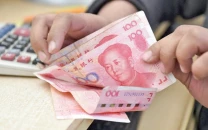Eating bank assets

Bad loans have persistently been a depressing issue for banks, affecting their profits and hampering their ability to lend money for constructive activities. A large part of these non-performing loans is said to have been given on political grounds without any collateral and due to pressure from influential people.
The most recent example is the Bank of Punjab scam in which Rs9 billion loans were doled out in imprudent lending, leading to the sacking of the bank president Hamesh Khan. Later, he was arrested and brought back from the US.
The 2008 global financial crisis was also triggered by the collapse of banks including giants like Lehman Brothers which heavily extended loans to people with a dubious track record. These people later failed to repay the money, sparking a financial crisis that gripped many countries of the developed world.
Govt borrowing
The government itself makes heavy borrowings from banks, particularly the State Bank, to cover the budget deficit and finance commodity purchases. The state-run Trading Corporation, which intervenes in commodity markets to stabilise them, is seeking millions from banks to import 1.2 million tons of sugar.
The International Monetary Fund (IMF) too has asked Pakistan to stop borrowing from the State Bank and improve its finances. According to estimates, the government has already borrowed over Rs170 billion from the SBP in violation of the IMF condition.
However, some encouraging news came from the central bank in its banking performance review in which it said bank lending to the government fell substantially by 10.7 per cent in the January-March quarter. On the other side, private sector borrowing increased slightly by 0.2 per cent.
But the State Bank cautioned that post-quarter statistics are showing that fresh lending for public sector commodity operations has in fact surpassed the previous level.
The story does not end here. The government after borrowing delays loan repayment and sometimes it takes months or years before the money is actually repaid.
Freeing up funds
The private sector has been facing challenging times, particularly since the global financial crisis struck in mid-2008. It lost some export markets because of a sharp economic slowdown in European states and the US, the two big export markets of Pakistan. Besides, it now faces stiff competition from regional countries such as India, China and Bangladesh in these export markets.
This makes it necessary for the manufacturers to modernise and adopt state-of-the-art technology, which will not only cut costs but also lead to production of high quality products. For developing their capacity, they need resources which can be provided by banks. But the financial institutions will only be able to offer loans generously when they have not enough money left after government borrowing.
When the private sector prospers, the country’s economy gets a boost and that is the pressing need of today when every country of the world is trying to take its economy to highs. These are times of battling in the economic arena and not fighting wars in the battlefield and this will make the difference between nations who race ahead, or lag behind. As the economy develops, eventually the people reap the benefit.
Published in the Express Tribune, June 14th, 2010.



















COMMENTS
Comments are moderated and generally will be posted if they are on-topic and not abusive.
For more information, please see our Comments FAQ